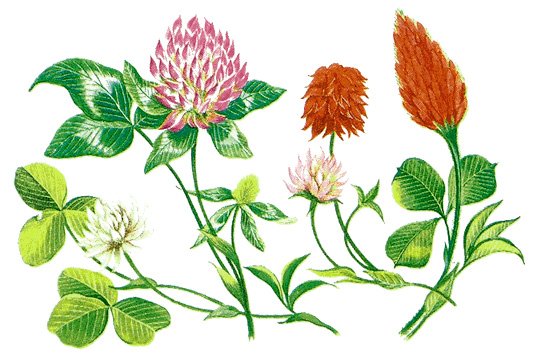Clover is a valuable crop used to feed farm animals and to enrich the soil. Clovers contain large amounts of protein and minerals. They are used for pasture and to make hay and silage. In addition, clovers enrich the soil by adding nitrogen to it (see Nitrogen (Nitrogen and life) ). Bacteria that live in clovers’ roots absorb and fix nitrogen from the air—that is, the bacteria convert nitrogen gas into nitrogen compounds that plants can use for growth and health. Clovers use only some of the nitrogen. After farmers plow clover into the soil, the rest of the fixed nitrogen becomes part of the soil and can be used by other plants.
Clovers are legumes (members of the pea family). There are about 240 kinds of true clovers, including the red, white, strawberry, and crimson species. A type called subterranean clover has burrs that bury themselves underground. Sweet clover and certain other plants in the pea family are commonly called clovers. However, botanists do not classify them in the same group.

The various clovers differ in how they grow. Some species are annuals—that is, they live for only one growing season. Others are perennials and can live for more than two growing seasons without being replanted. Species of clover also differ in appearance. They range from 6 inches to 3 feet (15 to 91 centimeters) in height, and have leaves that consist of three to six leaflets. Because four-leaf clovers are rare, some people believe they bring luck. The plants produce clusters of tiny flowers that are white, yellow, or any of various shades of red. The number of flowers in each cluster ranges from 5 to 200.
Clover probably originated in southwestern Asia Minor and southeastern Europe. Today, both wild and cultivated species grow throughout the world.
Red clover
has been used for centuries as a rotation crop. Today, it is used extensively as an animal food and soil-improving crop throughout Europe and northern and central North America. Red clover is generally planted with another crop, such as oats, barley, wheat, grasses, or certain legumes. It has purplish-red flowers and lives for two to three years.
There are three types of red clover—early flowering, late flowering, and wild. Early flowering red clover, which produces two to four hay crops a year, is the most commonly cultivated red clover in the United States.
White clover
is an important pasture crop, rotation crop, and animal and honey bee food. Its stems spread along the ground and take root in the soil at each node, the place where a leaf joins the stem. Because its roots are short and cannot reach water far underground, white clover is grown in regions that have an abundant supply of water. The plant is cultivated in the eastern United States and Canada, which have plentiful summer rain. Farmers also raise white clover on irrigated land in the western sections of those countries. It has white or pinkish-white flowers and can live for several years.
Strawberry clover
is a valuable pasture crop in the western United States, especially in areas that have extremely wet and salty soil. Other pasture crops cannot survive in such soil. Strawberry clover has pink flowers that grow in strawberrylike clusters.
Crimson clover
is widely cultivated in the Southeast and Pacific Coast regions of the United States. Farmers plant it in the fall to protect against erosion in the winter. Crimson clover provides pasture and hay and improves the soil. Its dark red flowers grow in pointed clusters.
Subterranean clover
provides pasture in winter and early spring in regions with mild winters. Raised chiefly in Australia, Chile, California, and Oregon, this clover has burs that bury themselves in the soil. The plant was named for this unusual growth method.
